Impressive harvest statistics from the 2021-22 hunting seasons again prove that now is a great time to be an Oklahoma big game hunter. Healthy herds and good conditions led to 117,629 deer being taken, making it the third-highest harvest total on record. Antlerless deer harvest accounted for 41 percent of the total, which falls right in line with the statewide annual goal of between 40 and 45 percent. Figure 1 shows total deer harvest numbers from 2004 to this past year.
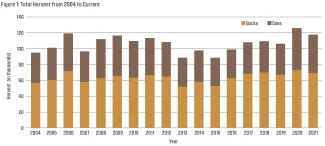
Gun seasons led the way with 68,879 deer harvested. These seasons are the traditional 16-day modern firearms season, the youth gun season, and the holiday antlerless deer gun season. Muzzleloader harvest decreased slightly from the previous year, with 12,228 deer taken during the nine-day season. But for the third year in a row, archery hunters set a record with 36,522 deer taken. Figure 2 represents success rates among the various hunting methods. Figure 3 shows individual seasons and the respective makeup of total harvest.
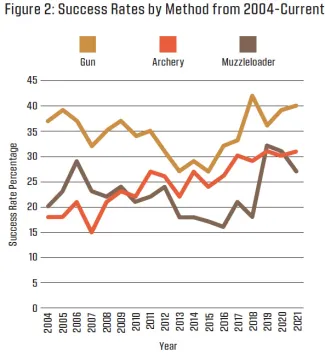
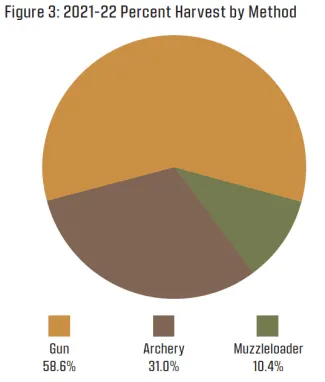
Oklahoma deer hunters are challenged with the wide diversity and various habitat types the state has to offer. With those variations comes different levels of quality deer habitat. Some counties enjoy the luxury of large expanses of public land, while others do not.
To represent each county fairly, Table 1 shows deer harvest by county with Wildlife Management Areas (WMAs) and other public lands removed. In terms of deer taken, the top three counties last year were Pittsburg with 4,071 deer harvested; Osage County with 4,055; and McCurtain County with 2,842.
WMAs and other Wildlife Department-managed public lands make up for a very small percentage of the state’s land area — about 3 percent. But the public lands accounted for 7.6 percent of the total harvest. With Oklahoma being the second most ecologically diverse state, second to only California, there is a style and type of hunt for everyone. Public land deer harvest statistics can be seen in Table 2.
Oklahoma also offers opportunities to harvest mule deer, which are found in the western areas of the state. Oklahoma is on the eastern fringe of the mule deer’s natural range, with the same being true for the pronghorn. This results in an inconsistent population across the landscape and fragmentation of those populations. However, hunters managed to take 254 mule deer during the 2021-22 season. Mule deer buck harvest totaled 243, while 11 does were taken. Table 3 represents mule deer harvest by county, sex, and method.
Deer Archery Season
Archery hunting continues to grow in popularity, which can be seen in a record-setting harvest for a third year in a row. Archers took 36,522 deer during the 2021-22 season, accounting for just over 30 percent of the total deer harvest. Antlerless deer made up 44 percent of the archery total. The annual Game Harvest Survey (GHS), a scientific survey conducted by the Wildlife Department, has been tracking hunter metrics for decades. The GHS estimated that 117,216 archers took to the field this past season with a deer license in hand.
Archery regulations were unchanged, with the season running from Oct. 1, 2021, through Jan. 15, 2022. The bag limit was six deer, with no more than two being antlered. A breakdown of harvest by sex and week can be seen in Figure 4. Archery hunter participation and harvest from years past is represented in Figure 5.

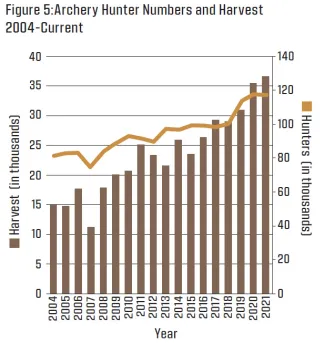
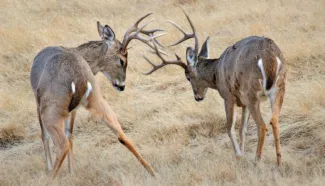
Deer Muzzleloader Season
Muzzleloader hunters were in the field from Oct. 23-31. Seasonal bag limit was four deer, only one of which could be antlered. Additional antlerless harvest was encouraged by the liberalization of antlerless bag limits offered in specific Antlerless Deer Zones as shown in Figure 10.

During the nine-day muzzleloader season, 12,228 deer were taken. That was a substantial drop from the previous year, a drop that could be attributed to warm temperatures across much of the state. The GHS estimated 85,248 hunters went afield to harvest 4,546 antlerless deer and 7,682 antlered deer. A breakdown of harvest by day and sex can be seen in Figure 6. Harvest and hunter participation from previous years is shown in Figure 7.
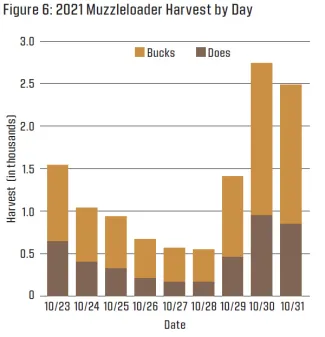
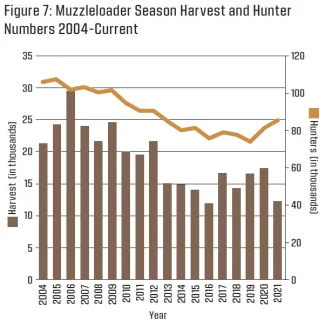
Deer Gun Seasons
Oklahoma’s modern gun season ran from Nov. 20-Dec. 5, 2021. Regulations were unchanged; hunters could take four deer, no more than one being antlered. An estimated 163,903 hunters managed to take 68,879 deer during Oklahoma’s various gun seasons, with 40 percent of the harvest being antlerless deer. See Figures 8 and 9.
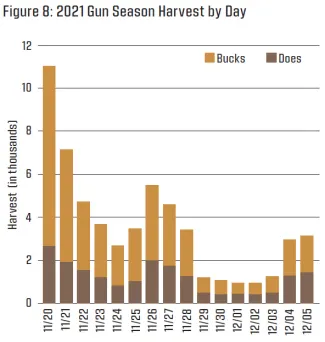
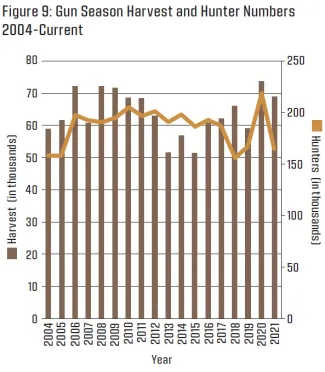
The holiday antlerless gun season occurred Dec. 18-31, 2021, and resulted in 6,362 antlerless deer being taken.
Youth hunters had the first shot with the youth deer gun season on Oct. 15-17. The youths took 4,809 deer those three days.
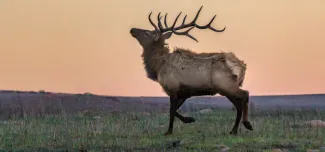
Elk
Hunters pursuing elk continue to enjoy growing elk populations across most of the state, with the bulk of the elk population occurring in the Special Southwest Zone of Caddo, Kiowa, and Comanche counties. Private-land hunting with written landowner permission during the state’s elk seasons and a draw hunt via ODWC’s controlled hunts program were the two main avenues for taking an elk. Hunters took 607 elk during the 2021-22 season, 272 of which were bulls. A breakdown by county, sex, and method is found in Table 4.
Pronghorn
Pronghorn roam the short-grass prairie in the western part of Oklahoma’s Panhandle. Pronghorn numbers are relatively small in the state, but populations continue to support limited hunting. Opportunity lies in over-the-counter archery licenses, once-in-a-lifetime controlled hunt permits, and landowner permits. Hunters took 152 pronghorns from the open hunting zone, which includes Cimarron County and that part of Texas County west of State Highway 136.
Those hunting in Cimarron County took 109 pronghorns. Archery hunters took 13 bucks, while gun hunters took 39 bucks and 57 does during the combined gun seasons.
Texas County yielded a total of 43 pronghorns. Archery hunters bagged eight pronghorns (7 bucks and a doe), while gun hunters took 35 pronghorns (10 bucks and 25 does). Table 5 shows a breakdown of harvest by county, sex, and method of take.
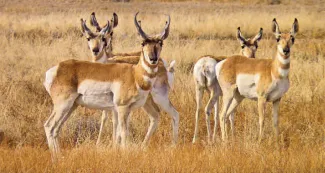

Deer Age Structure
Every year, the Wildlife Department enlists various sources to gather data from the state’s deer harvest. Those sources include Deer Management Assistance Program (DMAP) cooperative landowners, local meat processors, taxidermists, and our online Age My Deer program. The age data provide us with key information relating to the structure and health of Oklahoma’s deer herd. Figures 11 and 12 represent the ages at harvest for antlered and antlerless deer this past season. It’s apparent how the state hunters have taken to heart ODWC’s deer management slogan “Hunters in the Know … Let Young Bucks Grow!” over the past several years.
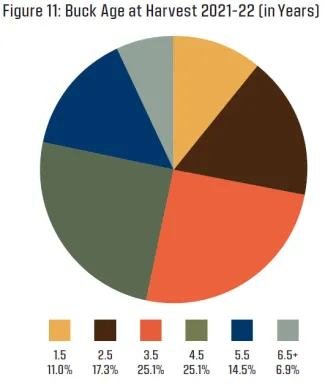
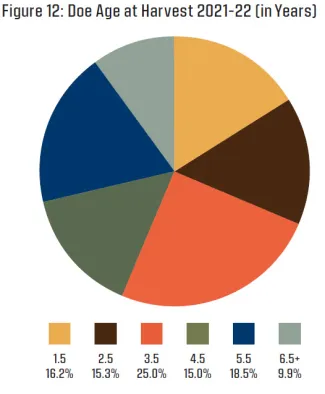
Conclusions
After several boosts likely due to COVID-19, the harvest and participation numbers from the 2021-22 big game seasons are back to levels that could be considered on-trend. Hunters continue to have ample opportunities to enjoy healthy and thriving populations across the state.
While deer harvest was slightly down compared to last year, hunters did achieve the biologists’ goal of an antlerless deer harvest between 40 and 45 percent. This is imperative to the statewide health of the deer herd.
Quality bucks continue to be harvested from every corner of the state, which is good news regardless of the reason anyone hunts. Continuing to use science-based regulations and partnering with our willing hunters as deer managers has resulted in a path of positivity. This path leads us to balanced deer herds in comparison to available habitat, and healthy age structures. With good habitat and healthy age structures come healthy populations and mature bucks. Who can argue with that?
But deer management is fluid and requires an adaptive management approach. The work never stops in pursuit of those goals.
Antlerless harvest will continue to be emphasized within Oklahoma’s deer management goals, and I know our hunters will take that challenge head-on. I’ve seen them do it before. So remember, every time that you decide to pull the trigger, release an arrow, or pass on a deer, you’re making a management decision that effects the deer population at your local level, whether that’s a 20-acre farm or a 1,000-acre ranch.
So, for even better big game hunting in years to come, keep in mind these simple slogans: “Hunters in the Know … Let Young Bucks Grow!” and “Hunters in the Know … Take a Doe!”
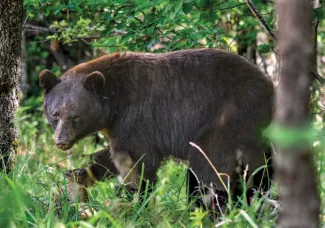
Black Bear Harvest Totals 70 for 2021
Black bear hunters enjoyed a good season in 2021, taking a total of 70 bears compared with 72 the year before.
Southeast Region Senior Wildlife Biologist Jeff Ford said the weather was warm and dry during the early part of archery season, leading to most of the bear harvest coming in the first 10 days.
Archery hunters took 66 black bears, while muzzleloader hunters could manage only four bears this past year in the open hunting area that includes all or portions of 12 counties in southeastern Oklahoma.

The record black bear harvest for Oklahoma was in 2018, when 85 bears were taken.
“There were some really big bears harvested, with several weighing over 500 pounds,” Ford said. “One tipped the scales at 613 pounds.”
This summer’s hot and dry conditions could make the 2022 black bear hunting more challenging, Ford said. “These conditions may affect the fall mast crop, making it harder to find some good bear sign in the woods. So concentrate on water resources to find sign. Bears will frequent watering holes when the weather is hot.”
“I would say the most important thing to help with having a successful bear season is to find an area with fresh bear sign and then just stay with it. Most successful bear hunters start early in the season, and you may have to sit all day.” Weather is a big factor during bear season; cold and wet conditions will make the bears less active.
Bears are all about putting on weight without burning calories to do so. They will always return to what is putting the most weight on them.
“If you’re going to hunt on public land where baiting for wildlife is not permitted, I would suggest to start scouting for a place to hunt in early September. Look for acorns (preferably white oak), which is most preferred by bears. The acorns will start falling around the first of October, and bears are going to be searching them out. If you’re not up on your tree species, there are some good apps you can download to help identify different trees.
All hunters wanting to pursue a black bear must buy either an archery or muzzleloader bear license before the opening dates of each season.
Archery bear season dates are defined in statute, running from Oct. 1 until the third Sunday in October. In 2022, archery bear season will close Oct. 16. Archery bear season has no harvest quota. Muzzleloader bear season will be Oct. 22-30, but the season will close as soon as a quota of 20 bears has been reached. Before they hunt, muzzleloader hunters must call for the latest bear quota information at (888) 901-3256.
For more on black bear hunting, consult the Oklahoma Fishing and Hunting Regulations, in the Go Outdoors Oklahoma mobile app for Apple and Android, or in print free at license dealers statewide.
The 21'-22' Big Game Report was originally published in the Sept/Oct 2022 Outdoor Oklahoma Magazine issue.
OUTDOOR OKLAHOMA MAGAZINE
BECOME A SUBSCRIBER TODAY!
ONLY $10 A YEAR, OR $25 FOR 3 YEARS!
To subscribe with a credit card, visit Go Outdoors Oklahoma at GoOutdoorsOklahoma.com and shop as a guest in the Outdoor Store, or log into your Go Outdoors Oklahoma account.
To subscribe with bill-me-later, check, or cash, call (800) 777-0019.